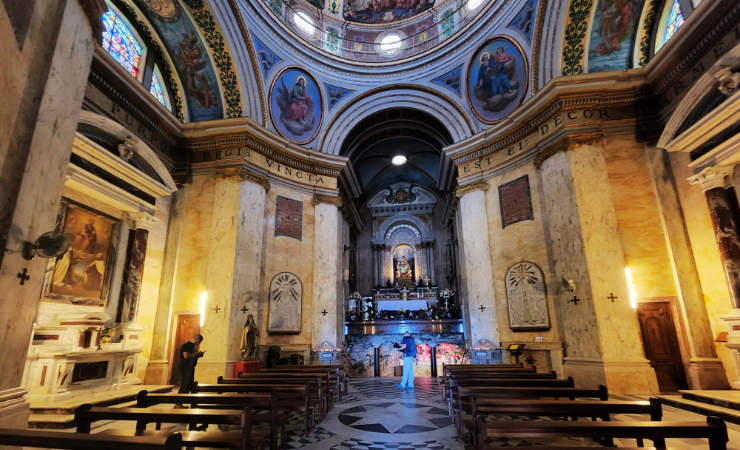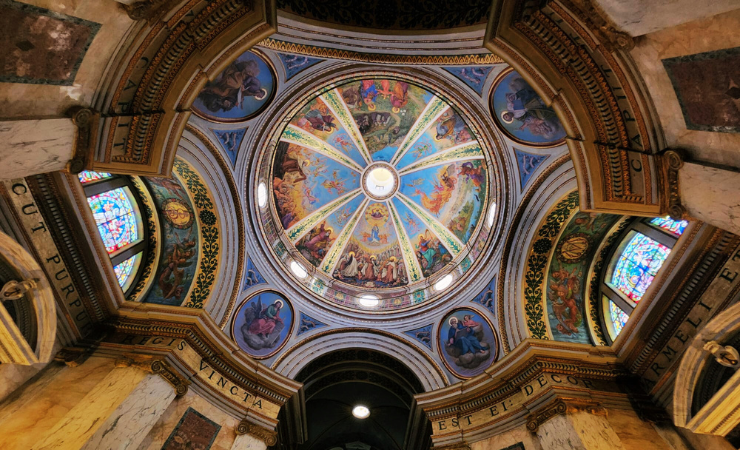Stella Maris: The Heart of the Carmelite Denomination
Located in Haifa, the Catholic Stella Maris Church and Monastery is dedicated to the Discalced Carmelite monks. It beckons visitors with its rich history and spiritual significance.

Location
Situated in the vibrant city of Haifa, the Stella Maris Church graces the slopes of Mount Carmel. With the Mediterranean Sea to its west and the bustling city to its east, it offers a serene spiritual retreat amidst urban surroundings.
Historical context
The Carmelite Beginnings
The roots of the Stella Maris Church and Monastery trace back to the 12th century during the Kingdom of Jerusalem’s reign. Religious hermits, inspired by the Prophet Elijah, began to inhabit the caves of Mount Carmel. By the early 13th century, these hermits sought a written rule of life from the Latin Patriarch of Jerusalem, Albert Avogadro. This marked the birth of the Carmelite Order, known as the ‘Order of the Brothers of Our Lady of Mount Carmel’.
However, the fall of Acre in 1291 to the Mamluks forced these monastic hermits to leave the Holy Land. The Carmelite order then spread across Europe, with King Saint Louis taking six Carmelites back to France in 1254.
But in 1631, the Discalced branch of the Order returned to the Holy Land, establishing a small monastery near a lighthouse on Mount Carmel only to be vacated in 1761 by Zahir al-Umar, leading to the monastery’s demolition.
The current location of the monastery is believed to be directly above a grotto where the prophet Elijah resided. Here, the Carmelites built a large church and monastery, which unfortunately faced destruction during Napoleon’s 1799 campaign. The church was later completely destroyed in 1821 by Abdullah Pasha of Acre. The present church and monastery were inaugurated in 1836 and were later recognized as a Minor Basilica by Pope Gregory XVI.



The Origin of the Name Stella Maris
During the rein of the Kingdom of Jerusalem’s in the 12th century CE, religious hermits, inspired by the Prophet Elijah, began to inhabit the caves of Mount Carmel. By the early 13th century, these hermits sought a written rule of life from the Latin Patriarch of Jerusalem, Albert Avogadro. This marked the birth of the Carmelite Order, known as the ‘Order of the Brothers of Our Lady of Mount Carmel’. The name “Stella Maris”, translating to “Star of the Sea”, was dedicated to the Virgin Mary.
The name “Stella Maris” is Latin for “Star of the Sea.” Traditionally, this title has been associated with the Virgin Mary. In Christian symbolism, the “Star of the Sea” represents guidance and hope, much like how sailors have historically used stars for navigation. The Virgin Mary, under this title, is seen as a guiding star leading the faithful, especially in times of distress, towards Jesus. The name signifies the role of the Virgin Mary as a beacon of hope, guidance, and protection for believers. In the context of the Stella Maris Church in Haifa, it emphasizes the church’s dedication to the Virgin Mary and its spiritual significance as a place of refuge and guidance.

A Dive Into the Stella Maris Church Architecture
Interior Design
The Stella Maris Church is a marvel of interior design. Its walls are adorned with white marble panels, meticulously arranged to give an illusion of painted walls. The brightness and placement of these panels captivate visitors, offering a serene ambiance.
The Dome
The church’s dome stands out, decorated by the Maltese Carmelite Luigi Poggi between 1924 and 1928. It showcases various biblical episodes, with the most prominent being the depiction of Prophet Elijah ascending to Heaven in a chariot of fire. This vivid representation serves as a focal point, drawing the eyes of all who enter.
The Main Altar
At the heart of the church is the main altar, crowned by a statue of the Virgin Mary. This statue, positioned on a pedestal carved from a cedar of Lebanon, holds significant reverence among local Christians. Directly beneath the altar lies Elijah’s cave, believed to be the dwelling place of the Prophet as mentioned in the Old Testament. Within this cave, an altar carved into the rock stands with a small statue of the Prophet, offering a place of reflection and prayer.
Carmelite Saints Embossments
The Basilica’s pilaster strips feature four embossments dedicated to renowned Carmelite Saints: St. Teresa of Avila, St. John of the Cross, St. Edith Stein, and St. Mariam Bouardy. These embossments serve as a tribute to the saints’ contributions to the Carmelite Order and their unwavering faith.
Byzantine Church Artifacts
Adjacent to the church’s entryway, a room displays a permanent Nativity Scene and artifacts from the ancient Byzantine Church that previously stood on this site. These artifacts offer a glimpse into the rich history of the location and its spiritual significance over the centuries.
Exterior Monuments
Outside the church, visitors are greeted by a pyramid memorial dedicated to the French soldiers who perished following Napoleon’s retreat in 1799. An inscription from 2nd Samuel 1:25, “How are the mighty fallen in the midst of the battle!”, serves as a poignant reminder of the sacrifices made. Opposite the church, a statue of the Immaculate Conception stands tall, a gift from the Chilean People to honor their nation’s Patroness.
The Stella Maris Church, with its intricate design and deep-rooted history, offers a spiritual haven for all who visit. Its architecture, combined with its religious significance, makes it a must-visit site in Haifa.
Sources and Additional Reading
Nearby Sites
Mukhraka (Keren Carmel): This site is believed to be where Prophet Elijah confronted the prophets of Baal. It holds significant religious importance and offers panoramic views of the surrounding areas.
Bahá’í Gardens: These terraced gardens cascade down Haifa’s hillside, culminating in the golden-domed Shrine of the Báb. Itis a recognized as a UNESCO World Heritage Site.
Elijah’s Cave: This cave is where it is believed the Prophet Elijah hid after his confrontation with the prophets of Baal. It’s a pilgrimage site for Jews, Muslims, Druze, and Christians.
- German Colony: The German Colony is Haifa’s restored historic district. With its well-preserved buildings, vibrant restaurants, and cafes, it’s a delightful blend of history and modern-day culture.



